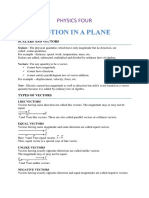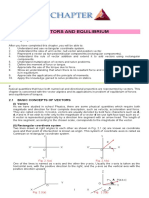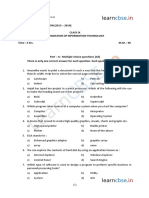Vector Introduction
Uploaded by
abd.maan.007Vector Introduction
Uploaded by
abd.maan.0071ST YEAR PHYSICS CHAPTER NO 2 TOPIC WISE NOTES
PHYSICAL QUANTITIES
Quantities which can be observed as well as measured are called physical
quantities.
OR
Quantities in terms of which all the laws of physics can be expressed are called
physical quantities.
TYPES OF PHYSICAL QUANTITIES
(i) Scalars (ii) Vectors
(I) SCALAR
Physical quantities which have magnitude only and does not require direction are called scalar quantities.
Examples: Time, distance, mass, temperature, speed, energy, work, volume, area, electric charge etc.
(II) VECTOR
Physical quantities which require both magnitude and direction are called vector quantities.
Examples: Force, velocity, displacement, torque, momentum, acceleration, weight, angular velocity, electric
intensity etc.
REPRESENTATION OF VECTORS
SYMBOLIC REPRESENTATION GRAPHICAL REPRESENTATION
Symbolically vectors are represented in two ways. Vectors are represented by a straight line with an arrow
• Bold Letter: Usually, vectors are represented by head at its one end.
bold face letter such as A, d, r and v etc. • The length of line represents magnitude of vector
Force F (according to suitable scale)
• Arrow Head: Vectors can also be represented by a • The arrow head represents the direction of vector.
letter with an arrow placed above or below the letter A
→
such as A or A
→
→
Force F
RECTANGULAR COORDINATE SYSTEM
COORDINATE AXES y-axis
(ordinate)
The two or three reference lines drawn at right angles (900) are
(2,3)
known as coordinate axes. 3
• The horizontal line is usually named as x-axes or sometime 2
called abscissa.
• The vertical line is usually named as y-axes or sometime 1
called ordinate. (0,0) x-axis
-3 -2 -1 1 2 3 (abscissa)
• The line perpendicular to both x and y –axes is called z – origin
-1
axes. Coordinate
axis
CARTESIAN SYSTEM -2
The set of these two or three mutually perpendicular -3
lines (coordinate axes) intersecting at a point is called
rectangular coordinate system or Cartesian System.
Cartesian System
ORIGIN
The point of intersection of coordinate axis is called origin.
CARTESIAN COORDINATES
Cartesian coordinates are the numbers which indicate the location of the point relative to a fixed reference point
(origin)
1ST YEAR PHYSICS – PROF ENGR MUHAMMAD QASIM ASLAM
1ST YEAR PHYSICS CHAPTER NO 2 TOPIC WISE NOTES
VECTOR IN PLANE VECTOR IN SPACE
DEFINITION
A vector in plane requires two dimensions or two A vector in space requires three dimensions or three
axes (x and y-axes). axes (x, y and z-axes).
COORDINATES
A vector in plane has two coordinates (a, b). A vector in space has three coordinates (a, b, c).
DIRECTION
Direction of a vector in plane requires one angle (θ) Direction of a vector in space requires three angles
which the vector makes from positive x-axes in anti- (,,) which the vector makes with x, y and z axes
clock wise direction. respectively.
DIAGRAM
EXAMPLE
Position of an insect sitting on a wall needs 2 axes Position of an insect flying inside a room needs 3 axes
and 2 coordinates so the position can be represented and 3 coordinates so the position can be represented by
by a plane vector. a space vector.
Which diagram is correct?
+y +y +y +y
-x +x -x +x -x +x -x +x
(A) (B ) ( D)
-y -y -y -y
Hint:
θ is the angle which a vector makes from positive x-axes in anti-clock wise direction.
Correct answer (d)
TYPE OF VECTORS
1. PARALLEL VECTORS A
B
• Two vectors pointing in the same direction are said to be parallel vectors.
Parallel Vectors
• Angle between parallel vectors is 00.
1ST YEAR PHYSICS – PROF ENGR MUHAMMAD QASIM ASLAM
1ST YEAR PHYSICS CHAPTER NO 2 TOPIC WISE NOTES
2. EQUAL VECTORS A
• Two vectors of same magnitude and pointing in the same direction are said to be equal B
Equal Vectors
vectors.
• Angle between equal vectors is 00.
3. ANTI-PARALLEL VECTORS A
• Two vectors pointing in opposite direction are said to be negative vector of each other. B
Anti-parallel Vectors
• Angle between anti-parallel vectors is 1800.
4. NEGATIVE VECTORS
A
• Two vectors of same magnitude and pointing in the opposite direction are said to be
B
negative vector of each other. Negative Vectors
• Angle between negative vectors is 1800.
5. COPLANAR VECTORS
• Two or more vectors lies on the same plane are called coplanar vectors.
6. NULL VECTOR
• A vector whose magnitude is zero and has arbitrary direction is called null vector or Coplanar Vectors
zero vector.
• Null vector cannot be drawn physically. ALWAYS REMEMBER
Resultant of vectors
Example: The sum of a vector and its negative vector is a null vector.
arranged in the form of
( )
A + −A = 0 polygon is also null vector.
7. UNIT VECTOR
• A vector whose magnitude is equal to one and use to specify the direction of a
CAN YOU SOLVE?
given vector is called unit vector. Which of the following
• A unit vector does not have a unit. is a unit vector?
• A unit vector in the direction of A is written as  which we read as ‘A hat’. ˆi ˆj
(a) +
FORMULA: 2 2
ˆi ˆj kˆ
→ →
If A is a vector with magnitude A, then A = AA Â =
A (b) + +
A 3 3 3
ˆ ˆ
(c) sin i + cos i
TYPES OF UNIT VECTORS:
(d) All of above
➢ SPECIFIED UNIT VECTORS
The unit vectors î , ˆj and k̂ are used to specify the direction of a vector along x, y and
z axes respectively.
➢ NON-SPECIFIED UNIT VECTORS
Unit vectors may also be defined for any direction other than x, y and z axes. Below
are the two more frequently used unit vectors.
• r̂ is the unit vector which represents the direction of the vector r.
• n̂ is the unit vector which represents the direction of a normal on a specified
surface.
r
r
1ST YEAR PHYSICS – PROF ENGR MUHAMMAD QASIM ASLAM
1ST YEAR PHYSICS CHAPTER NO 2 TOPIC WISE NOTES
VECTOR OPERATIONS
The basic mathematical operations (addition, subtraction,
multiplication) of algebra are also possible for vectors except division (two
vectors cannot be divided).
ADDITION OF VECTORS
As vectors cannot be added or subtracted by simple arithmetic rules so
we add them by a graphical method given below.
HEAD TO TAIL RULE
Head to tail rule is a graphical method for adding vectors.
• Step-1 (Joining Vectors): In this method the tail of the second vector
is placed on head of the first vector.
• Step-2 (Draw Resultant): The resultant vector can be drawn from tail
of the first vector to the head of the last vector.
A B B
A A
B R
Vectors to be
Step 1 Step 2
added
COMMUTATIVE PROPERTY:
→ → → →
From figure, it is clear that either we add A to B or B to A , the resultant
is same. i.e.,
→ → → →
A+B = B+A
It means that when vectors are added, the result is the same for any order of
addition.
Hence, vector addition is commutative.
RESULTANT VECTOR:
The resultant of a number of vectors of the same kind is that single vector which would have the same effect
as all the original vectors taken together.
• The tail of resultant vector coincides with the tail of first vector and head coincides with the head of the last vector.
IMPORTANT POINTS TO REMEMBER ABOUT VECTOR ADDITION
• Any number of vectors can be added graphically using head to tail rule.
• Scalars cannot be added to vectors.
• Only vectors of same kind can be added (e.g. force can be added to force only).
→ → → →
• Vector addition is commutative ( A + B = B + A ) as well as associative.
( A + B) + C = A + ( B + C )
• Magnitude of resultant is maximum when vectors are parallel. (Rmax = A+B).
• Magnitude of resultant is minimum when vectors are antiparallel. (Rmin = A−B).
• Magnitude of resultant vector when two vectors are perpendicular R = A 2 +B2
• The resultant of two vectors for any angle R = A2 + B2 + 2ABcos
VECTORS SUBTRACTION
The subtraction of a vector is equivalent to the addition of same vector with its direction reversed.
EXPLANATION
1ST YEAR PHYSICS – PROF ENGR MUHAMMAD QASIM ASLAM
1ST YEAR PHYSICS CHAPTER NO 2 TOPIC WISE NOTES
→ → → →
Consider two vectors A and B . To subtract B from vector A . First, take the DO YOU KNOW?
→ → → Vector subtraction is
negative of vector B . Add (−B ) into vector A graphically as shown in fig. So, non-commutative.
A − B = A + ( − B)
IDENTIFY THE RESULTANT VECTOR
C B
(a) A (b) B (c) C (d) None of above
A
Hint:
The tail of resultant vector coincides with the tail and head coincides with the head.
Correct answer (a)
MULTIPLICATION OF A VECTOR BY A SCALAR
Scalars can be divided into two categories.
1. Numbers
2. Scalar quantities
Let us discuss multiplication of vectors with both numbers and scalar quantities.
MULTIPLICATION BY NUMBERS
1. MULTIPLICATION BY A POSITIVE NUMBER
→
When a vector A is multiplied by a positive number n (n > 0) Then the product vector
→ →
will have magnitude equal to nA and same direction as that of A .
• Multiplication by positive number can affect magnitude of vector but cannot affect the
direction and unit of vector.
2. MULTIPLICATION BY A NEGATIVE NUMBER
→
When a vector A is multiplied by a negative number n (n < 0) then the product vector
→ →
will have magnitude equal to nA but direction opposite to that of A .
• Multiplication by negative number can affect magnitude as well as direction of vector
but cannot affect the unit of vector.
MULTIPLICATION WITH SCALAR QUANTITY
→
When a vector A is multiplied by a scalar quantity n, then the product vector will be a
→
new physical quantity whose dimensions are equal to the product of dimensions of n and A .
• Multiplication by a scalar quantity can also affect the units of vector.
EXAMPLES:
→ → →
• Product of mass m and velocity v is momentum [p = mv ]
→ → →
• Product of mass m and acceleration a is force [F = ma ]
1ST YEAR PHYSICS – PROF ENGR MUHAMMAD QASIM ASLAM
1ST YEAR PHYSICS CHAPTER NO 2 TOPIC WISE NOTES
CAN YOU SOLVE?
When a vector is multiplied by a positive number its magnitude will?
(a) Increase (b) decrease (c) remain same (d) All of above
Hint:
and decreases when multiplied by +1/2.
Magnitude remain same when multiplied by +1, increases when multiplied by +2
Correct answer (d )
PREVIOUS BOARDS MCQS
→ ^ ^
1. Unit vector of a given vector A = 4 i + 3 j is: MTN-19
4iˆ + 3jˆ 4iˆ + 3jˆ 4iˆ + 3jˆ
(a) (b) 1 (c) (d)
25 5 5
2. Mathematically the unit vector is given by: LHR-14
(a) Â = A A (b) Â = A/A (c) Â = A/A (d) None
3. A single vector having the same effect as all the original vectors taken together called: GRW-12
(a) Resultant vector (b) Equal vector (c) Position vector (d) Unit vector
4. Which one is vector quantity? AJK-13, FSD-14
(a) Length (b) Volume (c) Velocity (d) Work
5. The unit vector along y-axis is: DGK-15
(a) î (b) ˆj (c) k̂ (d) None of these
6. The magnitude of vector can never be: RWP-13
(a) Positive (b) Negative (c) Both A and B (d) None
1 ˆ 1 ˆ
7. The vector i+ j is a: FSD-15
2 2
(a) Null vector (b) Unit vector (c) Vector of magnitude 2 (d) None
8. When two vectors are anti-parallel the angle b/w them is: LHR-14
(a) Zero (b) 180° (c) 90° (d) 270°
9. Which is vector quantity? GRW-14
(a) Power (b) Inertia (c) Entropy (d) Tension
10. The resultant vector of two-unit vectors (mutually perpendicular) has magnitude __________.
1
(a) Unity (b) Zero (c) 2 (d)
2
ANSWERS OF THE ABOVE MCQZ
𝐴 ⃗ 4𝑖̂+3𝑗̂ 4𝑖̂+3𝑗̂ 4𝑖̂+3𝑗̂ 4𝑖̂+3𝑗̂
1. (c) 𝐴̂ = = = = =
𝐴 √4 2 +32 √16+9 √25 5
2. (c) Unit vector 𝐴̂ = 𝐴̂/𝐴
3. (a) Resultant vector
4. (c) Velocity is a quantity which have both magnitude and direction.
5. (b) unit vector along y-axis is 𝑗̂
6. (b) From A = √𝐴𝑥 2 + 𝐴𝑦 2 this shows is that magnitude is always positive.
7. (b) As, the magnitude of A is 1 so it’s a unit vector.
8. (b) Unit vector
9. (d) From all of given, Torque is a quantity which have both magnitude and direction.
10. (c) As |𝐴̂| = 1 so R = √𝐴̂2 + 𝐴̂2 = √1 + 1 = √2
1ST YEAR PHYSICS – PROF ENGR MUHAMMAD QASIM ASLAM
You might also like
- Yabello Ifa Boru Special Boarding Secondary School Physics Short Note For Grade 11 BY: Wondimu Getachew (2016 EC)No ratings yetYabello Ifa Boru Special Boarding Secondary School Physics Short Note For Grade 11 BY: Wondimu Getachew (2016 EC)91 pages
- Physical Quantity: Vectors I-Year Jee (Advanced) PhysicsNo ratings yetPhysical Quantity: Vectors I-Year Jee (Advanced) Physics18 pages
- Unit I Vector Analysis: 1 Scalars and VectorsNo ratings yetUnit I Vector Analysis: 1 Scalars and Vectors45 pages
- 10+1 Physics Book-3 Vectors & Motion in A PlaneNo ratings yet10+1 Physics Book-3 Vectors & Motion in A Plane112 pages
- Lecture - 1 - AV-231 - Recap of Vector AlgebraNo ratings yetLecture - 1 - AV-231 - Recap of Vector Algebra52 pages
- Engg GZ Physics 1 VectorandBasicsMaths (Package) - 1588243407401 PDFNo ratings yetEngg GZ Physics 1 VectorandBasicsMaths (Package) - 1588243407401 PDF58 pages
- FSC Physics Chapter No. 2 (Theory Notes)No ratings yetFSC Physics Chapter No. 2 (Theory Notes)26 pages
- NEET-UG - JEE (Main) Absolute Physics Vol. - 1No ratings yetNEET-UG - JEE (Main) Absolute Physics Vol. - 127 pages
- MF006 Lecture 2 - Introduction To VectorsNo ratings yetMF006 Lecture 2 - Introduction To Vectors32 pages
- Vectors (Tools For Physics) : Chapter 3, Part INo ratings yetVectors (Tools For Physics) : Chapter 3, Part I14 pages
- Lecture - 1 - DR Nader Shehata - Review On Vectors and ScalarsNo ratings yetLecture - 1 - DR Nader Shehata - Review On Vectors and Scalars41 pages
- 2nd-Chapter-Vector and Motion in a Straight LineNo ratings yet2nd-Chapter-Vector and Motion in a Straight Line67 pages
- Technical Sciences Grade 10 Term 1 Week 4_2021No ratings yetTechnical Sciences Grade 10 Term 1 Week 4_20214 pages
- Components of The Smart Eye Glasses Price EstimationNo ratings yetComponents of The Smart Eye Glasses Price Estimation2 pages
- The Management of Productivity and Technology in Manufacturing PDF100% (2)The Management of Productivity and Technology in Manufacturing PDF333 pages
- Request For Quotation of Prices: LFN TradingNo ratings yetRequest For Quotation of Prices: LFN Trading5 pages
- Tensioning Issues On Chevrolet/Daewoo 16V Petrol EnginesNo ratings yetTensioning Issues On Chevrolet/Daewoo 16V Petrol Engines4 pages
- The Five Generic Competitive StrategiesNo ratings yetThe Five Generic Competitive Strategies39 pages
- Promotional Strategies & Print Ad For Cold Creams100% (1)Promotional Strategies & Print Ad For Cold Creams12 pages
- Learn: Half Yearly Examination (2013 - 2014) Class Ix Foundation of Information Technology Time: 3 Hrs. M.M.: 90No ratings yetLearn: Half Yearly Examination (2013 - 2014) Class Ix Foundation of Information Technology Time: 3 Hrs. M.M.: 9023 pages
- Agrement For Sale - First Floor Office 1 - RA Busines PArk 800722No ratings yetAgrement For Sale - First Floor Office 1 - RA Busines PArk 80072262 pages
- Habitat The Place Where A Plant or Any Living Thing Lives Naturally AdaptationNo ratings yetHabitat The Place Where A Plant or Any Living Thing Lives Naturally Adaptation6 pages
- The Karnataka Coop Socities Rules, 2013No ratings yetThe Karnataka Coop Socities Rules, 201356 pages
- Yabello Ifa Boru Special Boarding Secondary School Physics Short Note For Grade 11 BY: Wondimu Getachew (2016 EC)Yabello Ifa Boru Special Boarding Secondary School Physics Short Note For Grade 11 BY: Wondimu Getachew (2016 EC)
- Physical Quantity: Vectors I-Year Jee (Advanced) PhysicsPhysical Quantity: Vectors I-Year Jee (Advanced) Physics
- Engg GZ Physics 1 VectorandBasicsMaths (Package) - 1588243407401 PDFEngg GZ Physics 1 VectorandBasicsMaths (Package) - 1588243407401 PDF
- Lecture - 1 - DR Nader Shehata - Review On Vectors and ScalarsLecture - 1 - DR Nader Shehata - Review On Vectors and Scalars
- Vector and Tensor Analysis with ApplicationsFrom EverandVector and Tensor Analysis with Applications
- Engineering Formulas: QuickStudy Laminated Reference GuideFrom EverandEngineering Formulas: QuickStudy Laminated Reference Guide
- Components of The Smart Eye Glasses Price EstimationComponents of The Smart Eye Glasses Price Estimation
- The Management of Productivity and Technology in Manufacturing PDFThe Management of Productivity and Technology in Manufacturing PDF
- Tensioning Issues On Chevrolet/Daewoo 16V Petrol EnginesTensioning Issues On Chevrolet/Daewoo 16V Petrol Engines
- Learn: Half Yearly Examination (2013 - 2014) Class Ix Foundation of Information Technology Time: 3 Hrs. M.M.: 90Learn: Half Yearly Examination (2013 - 2014) Class Ix Foundation of Information Technology Time: 3 Hrs. M.M.: 90
- Agrement For Sale - First Floor Office 1 - RA Busines PArk 800722Agrement For Sale - First Floor Office 1 - RA Busines PArk 800722
- Habitat The Place Where A Plant or Any Living Thing Lives Naturally AdaptationHabitat The Place Where A Plant or Any Living Thing Lives Naturally Adaptation

























































































